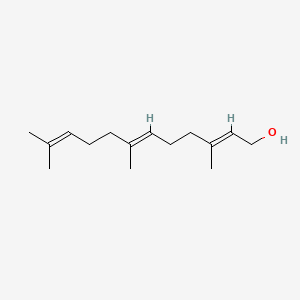| MeSH term | MeSH ID | Detail |
|---|---|---|
| HIV Infections | D015658 | 20 associated lipids |
| Dermatitis, Allergic Contact | D017449 | 20 associated lipids |
| Neurilemmoma | D009442 | 10 associated lipids |
| Head Injuries, Closed | D016489 | 5 associated lipids |
| Insulin Resistance | D007333 | 99 associated lipids |
| Candidiasis, Oral | D002180 | 11 associated lipids |
| Neuralgia | D009437 | 28 associated lipids |
| Lung Injury | D055370 | 14 associated lipids |
| Neoplasms, Glandular and Epithelial | D009375 | 12 associated lipids |
| Nerve Sheath Neoplasms | D018317 | 4 associated lipids |
2E,6E-farnesol
2e,6e-farnesol is a lipid of Prenol Lipids (PR) class. 2e,6e-farnesol is associated with abnormalities such as Granulomatous Disease, Chronic, pathologic fistula and Cavitation. The involved functions are known as Regulation, Metabolic Inhibition, cholesterol biosynthetic process, Process and Transcription, Genetic. 2e,6e-farnesol often locates in Plasma membrane, Cytoplasmic matrix, cornified envelope, Epidermis and peroxisome. The associated genes with 2E,6E-farnesol are RAB3A gene, FOSL1 gene, CASP8AP2 gene, RCC1 gene and GALE gene. The related lipids are Sterols, Membrane Lipids and Steroids.
Cross Reference
Introduction
To understand associated biological information of 2E,6E-farnesol, we collected biological information of abnormalities, associated pathways, cellular/molecular locations, biological functions, related genes/proteins, lipids and common seen animal/experimental models with organized paragraphs from literatures.
What diseases are associated with 2E,6E-farnesol?
2E,6E-farnesol is suspected in Granulomatous Disease, Chronic, pathologic fistula and other diseases in descending order of the highest number of associated sentences.
Related references are mostly published in these journals:
| Disease | Cross reference | Weighted score | Related literature |
|---|
Possible diseases from mapped MeSH terms on references
We collected disease MeSH terms mapped to the references associated with 2E,6E-farnesol
PubChem Associated disorders and diseases
What pathways are associated with 2E,6E-farnesol
There are no associated biomedical information in the current reference collection.
PubChem Biomolecular Interactions and Pathways
Link to PubChem Biomolecular Interactions and PathwaysWhat cellular locations are associated with 2E,6E-farnesol?
Visualization in cellular structure
Associated locations are in red color. Not associated locations are in black.
Related references are published most in these journals:
| Location | Cross reference | Weighted score | Related literatures |
|---|
What functions are associated with 2E,6E-farnesol?
Related references are published most in these journals:
| Function | Cross reference | Weighted score | Related literatures |
|---|
What lipids are associated with 2E,6E-farnesol?
Related references are published most in these journals:
| Lipid concept | Cross reference | Weighted score | Related literatures |
|---|
What genes are associated with 2E,6E-farnesol?
Related references are published most in these journals:
| Gene | Cross reference | Weighted score | Related literatures |
|---|
What common seen animal models are associated with 2E,6E-farnesol?
There are no associated biomedical information in the current reference collection.
NCBI Entrez Crosslinks
All references with 2E,6E-farnesol
Download all related citations| Authors | Title | Published | Journal | PubMed Link |
|---|---|---|---|---|
| Supuran CT | Nanoparticles for controlled release of anti-biofilm agents WO2014130994 (A1): a patent evaluation. | 2015 | Expert Opin Ther Pat | pmid:26028186 |
| Rosales A et al. | Synthesis of (±)-aureol by bioinspired rearrangements. | 2015 | J. Org. Chem. | pmid:25591135 |
| Brilhante RS et al. | Histoplasma capsulatum in planktonic and biofilm forms: in vitro susceptibility to amphotericin B, itraconazole and farnesol. | 2015 | J. Med. Microbiol. | pmid:25657300 |
| Abdel-Rhman SH et al. | Effect of Tyrosol and Farnesol on Virulence and Antibiotic Resistance of Clinical Isolates of Pseudomonas aeruginosa. | 2015 | Biomed Res Int | pmid:26844228 |
| Kostoulias X et al. | Impact of a Cross-Kingdom Signaling Molecule of Candida albicans on Acinetobacter baumannii Physiology. | 2015 | Antimicrob. Agents Chemother. | pmid:26482299 |
| Hameiri-Grossman M et al. | The association between let-7, RAS and HIF-1α in Ewing Sarcoma tumor growth. | 2015 | Oncotarget | pmid:26393682 |
| Lopez-Medina E et al. | Candida albicans Inhibits Pseudomonas aeruginosa Virulence through Suppression of Pyochelin and Pyoverdine Biosynthesis. | 2015 | PLoS Pathog. | pmid:26313907 |
| Joo JH et al. | Farnesol activates the intrinsic pathway of apoptosis and the ATF4-ATF3-CHOP cascade of ER stress in human T lymphoblastic leukemia Molt4 cells. | 2015 | Biochem. Pharmacol. | pmid:26275811 |
| Krause J et al. | Prostaglandin E2 from Candida albicans Stimulates the Growth of Staphylococcus aureus in Mixed Biofilms. | 2015 | PLoS ONE | pmid:26262843 |
| Strube-Bloss MF et al. | Extracting the Behaviorally Relevant Stimulus: Unique Neural Representation of Farnesol, a Component of the Recruitment Pheromone of Bombus terrestris. | 2015 | PLoS ONE | pmid:26340263 |
